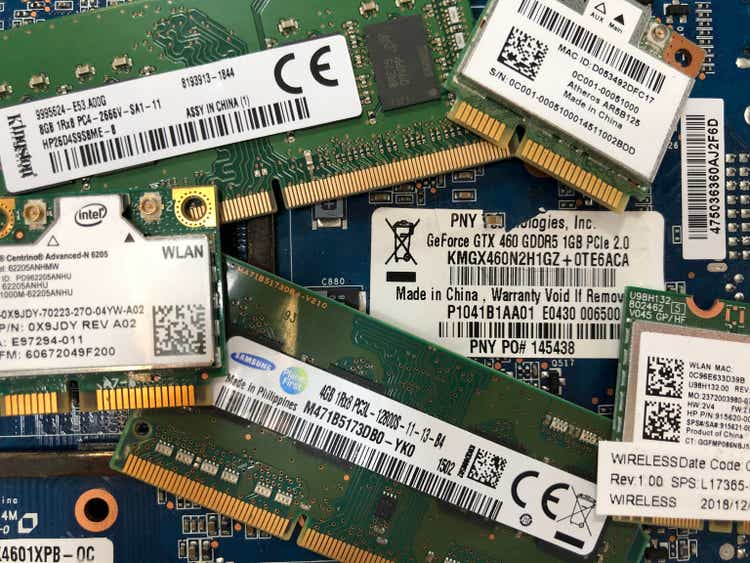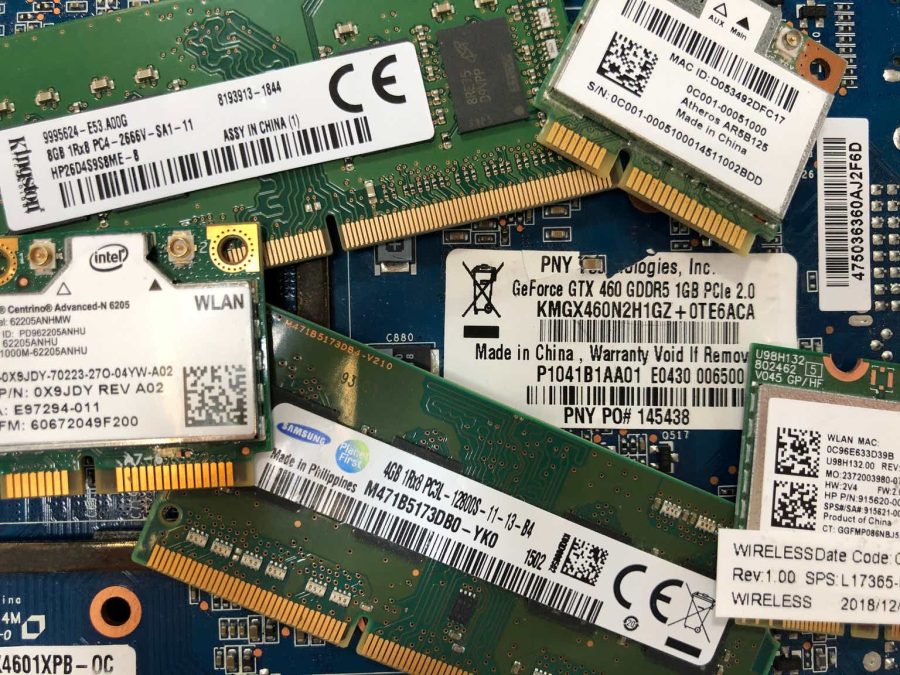Summary:
- Intel is scheduled to release its earnings tomorrow, April 25. The release will be the company’s first to separate the foundry business from the design business.
- Currently, INTC lacks TSMC’s edge in courting certain customers, such as chip designers that are in competition with Intel’s product design business.
- Intel’s foundry growth has been decelerating in recent quarters.
- On the bright side, the non-foundry segments have swung from declines to positive growth.
- Intel is no longer the “deep value name” it once was, for this reason, combined with limited foundry potential, I just think of it as a hold.
Small Pile of Computer Microchips (GPU) FinkAvenue
Intel (NASDAQ:INTC) is scheduled to release its earnings tomorrow, April 25. There’s a lot at stake in this release. The company is set to report the financials of its foundry separately from those in its design business–a first in its history. If the foundry business shows strong results, that could pique the interest of investors, who this year, have been buying shares of TSMC (TSM) while selling shares of Intel.
Intel is trying very hard to make itself into the next big player in the global foundry business. It is receiving substantial sums of money from the U.S. government for this purpose, having received $8.5 billion in subsidies since the CHIPS Act (the spending bill that allocated government funds for semiconductor manufacturing) went into effect. Other foundries are getting CHIPS Act money as well, but Intel is getting the lion’s share. Intel ostensibly got more money because it is investing more money than its competitors in U.S. chip manufacturing. To get CHIPS act money, a company must not only sell semiconductors to U.S. buyers, but also build the chips in the United States. Intel, being a U.S. company, has an advantage in this area, with plans to build a $100 billion facility on its home turf.
That being said, larger amounts of subsidy money do not automatically mean that Intel will become a foundry giant. Its management clearly wants it to be such a player, but it has to clear many hurdles before it can get there. Intel Foundry Services did $291 million in revenue in the fourth quarter. The 63% growth was quite high, but full year growth was 103%, meaning that Intel’s Q4 foundry revenue had decelerated from earlier in the year. TSMC’s revenue growth was 35% in March, and accelerated for the period, so if Intel Foundry’s revenue continues to decelerate, then it will eventually be growing at the same pace as a larger competitor. That would make it impossible to gain significant market share.
When I last covered Intel, I highlighted its weak competitive position against TSMC as a concern. Today, with earnings around the corner, I have a more immediate concern: whether the foundry business can perform well enough, in absolute terms, to make up for weakness in the chip design business. In fiscal 2023, Intel delivered the following segment results:
-
$29.3 billion in client computing, down 8%.
-
$15.5 billion in data center and AI, down 20%.
-
$5.8 billion in network and edge, down 31%.
-
$2.1 billion in Mobileye revenue, up 11%.
-
$952 million in foundry revenue, up 103%.
The growth in foundry revenue was very good, but note that foundry category was only 1.77% of total revenue, while the two growing categories (Foundry and Mobileye) were 5.68% of the total. It will take a lot of sustained growth in Foundry services before that segment can really move the needle for Intel as a whole. If a segment starts at 1.7% and grows at 100% every year, while the other segments grow at 0%, it takes three years for the fast-growing segment to become a mere 12.1% of the whole. On top of that, Intel Foundry’s Q4 growth was down from earlier quarters, so we are not actually seeing 100% year-over-year growth, like that assumed in the exercise above.
Intel 2023 results (Data from Intel, table by author)
In general, I’m expecting Intel’s foundry revenue growth to decelerate. One reason is that the company competes with its clients. It designs chips similar to those offered by AMD (AMD). Would that company feel comfortable handing its latest tech breakthroughs to a competitor in the form of engineering blueprints? It seems unlikely. Granted, there are other chip companies that do not compete with Intel, such as NVIDIA. But companies like AMD and Apple probably wouldn’t want to share their trade secrets with a competitor. They’d likely prefer to go with a non-competitor like TSMC.
What Analysts are Expecting
It’s one thing to observe how Intel did in previous earnings releases, but quite another to predict that it will do the same again. Analysts have fairly modest expectations of the company’s upcoming release. Below, you can see what analysts expect, alongside the growth rates that would be achieved if every metric were exactly in line with estimates:
|
Raw number |
Growth rate implied |
|
|
Revenue |
$12.78B |
9.2% |
|
Adjusted EPS |
$0.14 |
N/M (negative in the prior year quarter). |
|
GAAP EPS |
$-0.15 |
77% improvement (negative figure becoming less negative). |
The expectations here might not look great on the surface of things, but each of the metrics above is expected to see an improvement. The GAAP EPS figure for example is expected to improve by 77%, which would be a major step toward GAAP profitability.
Most likely, it’s the Foundry results that analysts will be paying the most attention to. Although it’s small as a percentage of the whole company, Intel Foundry Services is the segment that has the most obvious path to growth. Some of the issues in the chip design business appear irreversible; for example:
-
The permanent loss of all of Apple’s (AAPL) business in 2020 with the launch of Apple’s M Series chips.
-
Windows PCs–Intel’s traditional bread and butter–losing ground to smartphones, which mostly run either Apple A-series chips or Qualcomm (QCOM) Snapdragon chips.
-
NVIDIA (NVDA) and AMD’s (AMD) continued dominance of gaming chips (the former dominates AI accelerator chips as well).
It’s hard to picture these trends reversing. On the other hand, the growth in Intel’s data center business was pretty strong, growing at 33%. That’s still less growth than NVIDIA and AMD did in the server last quarter, so the Foundry is really Intel’s chance to shine.
Does the company offer guidance for that segment? The answer is both yes and no. The Q4 earnings call and presentation did not include specific foundry guidance for Q1, but the company said that it expects $15B in foundry revenue by 2030. Using the 2023 revenue figure ($952 million) as the base amount, then we have a 48.2% CAGR to 2030. Applying that rate to 2024, we’d expect $1.41B in 2024 foundry revenue, which would be $352M if spread out evenly across each quarter. If analysts are taking Intel’s “$15 billion in 2030” guidance to heart, then, they likely expect something close to $352 million from the Foundry in Q1. If the figure comes up much less than that, or if the segment produces yet another multi-billion dollar loss, that could trigger selling in INTC shares.
Where Things Are Headed
Having looked at management guidance and analyst expectations, it’s time to reveal what I expect from Intel in Q1.
As Intel will be reporting its Foundry results in more detail than before in Q1, I have quite a few things to estimate here.
Here’s what I expect:
-
Foundry revenue will be $352 million based on my previous estimate.
-
In the fourth quarter, Intel’s non-foundry segments swung back to a positive growth rate after declining earlier in the year. Specifically, they grew at 8.145%. If we assume that they grow at that rate again while the Foundry segment grows to $352 million, then we get to $12.742 billion in Q1 revenue. My foundry growth estimate is based on a company statement, while my extrapolation of continued positive growth to the first quarter is consistent with the strength TSM showed in the first quarter.
-
My estimate is about $40 million shy of the $12.78 million average analyst estimate, since we’re working with tens of billions here, I’ll say that I expect revenue to be in line.
-
It seems fair to assume the EBIT margin will remain negative in Q1, as the company has said it expects multi-billion dollar losses in the foundry segment alone. So I’ll apply last year’s -12.5% EBIT margin to my revenue estimate, taking us to a $-1.59 billion EBIT loss.
-
In 2023, Intel actually recovered more taxes than it paid, likely due to the negative GAAP earnings. The amounts recovered varied quite a bit quarter by quarter, though, so I can’t say what the tax recovery will be in Q1. Also, interest has been a negligible line item for Intel in recent quarters. For this reason, I’ll just call $-1.59 billion my earnings estimate.
-
That results in $-0.37 in earnings per share, which would be a miss if it were what the company reported for Q1.
So on the whole, I expect a mixed release. I think revenue will be in line and earnings will miss.
Valuation
So far, I’ve highlighted several positives for Intel in this article. The persistently strong foundry growth, the reversal of the previous negative growth rate in the non-foundry segments, and the relatively high gross margins, for example. However, I wouldn’t buy INTC stock today, and the reasons for this have to do with valuation. At today’s prices, INTC trades at:
-
86 times trailing GAAP earnings.
-
25.4 times forward adjusted earnings.
-
2.6 times sales.
-
1.38 times book.
-
12.77 times operating cash flow.
On the other hand, we have TSMC, which can be bought for a relatively modest 22 times earnings, and an only slightly more expensive 14.7 times operating cash flow. All while TSMC outscores INTC on growth in Seeking Alpha Quant! Intel’s combination of a D on valuation and a D- on growth leaves much to be desired. And my earnings estimates have the company only doing a minor amount of growth in Q1. At today’s prices, the stock is just a hold. I would not be betting on it ahead of earnings, long or short.
Analyst’s Disclosure: I/we have no stock, option or similar derivative position in any of the companies mentioned, and no plans to initiate any such positions within the next 72 hours. I wrote this article myself, and it expresses my own opinions. I am not receiving compensation for it (other than from Seeking Alpha). I have no business relationship with any company whose stock is mentioned in this article.
Seeking Alpha’s Disclosure: Past performance is no guarantee of future results. No recommendation or advice is being given as to whether any investment is suitable for a particular investor. Any views or opinions expressed above may not reflect those of Seeking Alpha as a whole. Seeking Alpha is not a licensed securities dealer, broker or US investment adviser or investment bank. Our analysts are third party authors that include both professional investors and individual investors who may not be licensed or certified by any institute or regulatory body.
